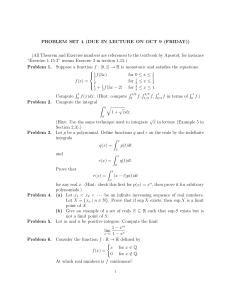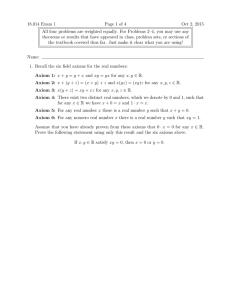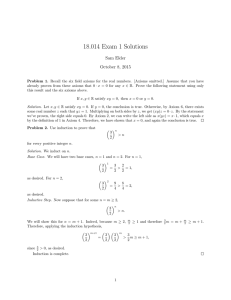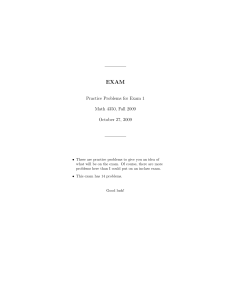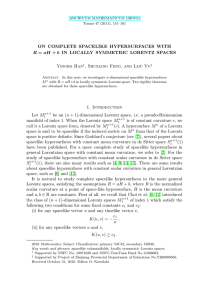18.014 Problem Set 4 Solutions Sam Elder October 8, 2015
advertisement
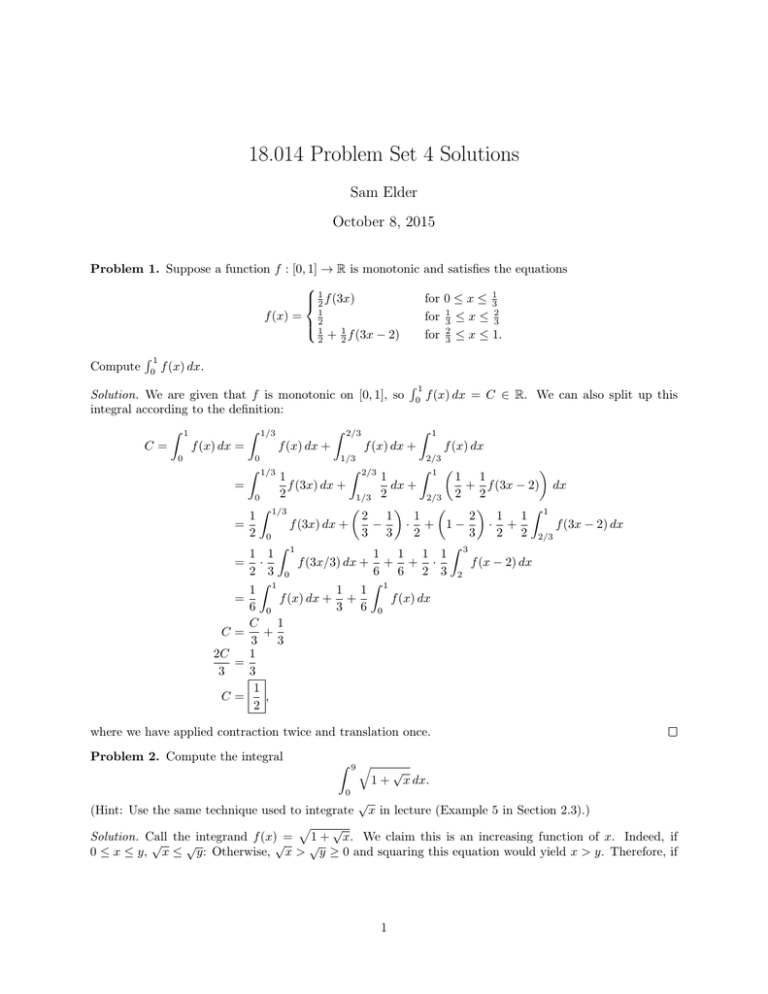
18.014 Problem Set 4 Solutions
Sam Elder
October 8, 2015
Problem 1. Suppose a function f : [0, 1] → R is monotonic
1
2 f (3x)
f (x) = 12
1 1
2 + 2 f (3x − 2)
Compute
R1
0
and satisfies the equations
for 0 ≤ x ≤ 31
for 31 ≤ x ≤ 23
for 23 ≤ x ≤ 1.
f (x) dx.
Solution. We are given that f is monotonic on [0, 1], so
integral according to the definition:
Z
C=
1
Z
1/3
f (x) dx =
0
=
=
=
C=
2C
=
3
C=
f (x) dx = C ∈ R. We can also split up this
Z
1
f (x) dx +
1/3
f (x) dx
2/3
Z 1 1
1 1
dx +
+ f (3x − 2) dx
2 2
1/3 2
2/3
0
Z 1/3
Z
1
2 1
2
1
1 1 1
f (3x) dx +
−
f (3x − 2) dx
· + 1−
· +
2 0
3 3
2
3
2 2 2/3
Z
Z
1 1 1
1 1 1 1 3
·
f (3x/3) dx + + + ·
f (x − 2) dx
2 3 0
6 6 2 3 2
Z
Z
1 1
1 1 1
f (x) dx + +
f (x) dx
6 0
3 6 0
1
C
+
3
3
1
3
1
,
2
Z
=
0
2/3
Z
f (x) dx +
0
R1
1/3
1
f (3x) dx +
2
Z
2/3
where we have applied contraction twice and translation once.
Problem 2. Compute the integral
Z
9
q
1+
0
√
x dx.
√
(Hint: Use the same technique used to integrate x in lecture (Example 5 in Section 2.3).)
p
√
Solution. Call
1 + x. We claim this is an increasing function of x. Indeed, if
√ the√integrand f (x)√= √
0 ≤ x ≤ y, x ≤ y: Otherwise, x > y ≥ 0 and squaring this equation would yield x > y. Therefore, if
1
p
p
√
√
√
√
√
√
0 ≤ y ≤ x, y ≤ x, 1 + y ≤ 1 + x and applying the statement one more time, 1 + y ≤ 1 + x
as desired.
we can apply
area method from lecture or Section 2.3. Since f (0) =
p the√complementary
p Therefore,
√
√
1 + 0 = 1 and f (9) = 1 + 9 = 4 = 2, we divide up the area of the rectangle [0, 9] × [0, 2]:
Z
9
18 = 9 · 2 =
Z
f (x) dx +
Z
2
(y 4 − 2y 2 + 1) dy =
1
f −1 (y) dy.
1
0
Now we must compute the inverse of f : If y =
As a polynomial, this is easy to integrate:
2
p
√
√
1 + x, then y 2 = 1 + x, so x = (y 2 − 1)2 = y 4 − 2y 2 + 1.
2 32 16
1 5 2 3
1 2
y − y + y =
−
+2 −
− +1
5
3
5
3
5 3
1
93 − 70 + 15
38
31 14
−
+1=
=
.
=
5
3
15
15
Therefore, substituting into our previous equation,
Z
9
38
270 − 38
232
=
=
.
15
15
15
f (x) dx = 18 −
0
Problem 3. Let p be a polynomial. Define functions q and r on the reals by the indefinite integrals
Z x
Z x
q(x) =
p(t) dt and r(x) =
q(t) dt.
0
0
Prove that
x
Z
(x − t)p(t) dt
r(x) =
0
for any real x. (Hint: check this first for p(x) = xn , then prove it for arbitrary polynomials.)
Solution. For simplicity of notation, call
Z
x
(x − t)p(t) dt,
s(x) =
0
so we must show that r(x) = s(x). As motivation/inspiration, we first check the result for monomials. If
p(x) = xn , then
Z x
xn+1
.
q(x) =
tn dt =
n+1
0
Z x n+1
t
xn+2
r(x) =
dt =
(n + 1)(n + 2)
0 n+1
Z x
Z x
Z x
xn+1
xn+2
n
n
s(x) =
(x − t)t dt = x
t dt −
tn+1 dt = x
−
n+1 n+2
0
0
0
n+2
n+2
x
x
=
((n + 2) − (n + 1)) =
,
(n + 1)(n + 2)
(n + 1)(n + 2)
so indeed, r(x) = s(x) if p(x) = xn for any nonnegative integer n. Now we apply the same steps in the
2
Pm
general case: Suppose that p(x) = k=0 ak xk . By linearity,
Z xX
Z x
m
m
m
X
X
xk+1
q(x) =
ak tk dt =
ak
tk dt =
ak
k+1
0 k=0
0
k=0
k=0
Z
Z xX
m
m
m
x
X ak
X
tk+1
ak xk+2
tk+1 dt =
r(x) =
dt =
ak
k+1
k+1 0
(k + 1)(k + 2)
0 k=0
k=0
k=0
Z x
Z
Z x
m
m
m
m
m
x
X
X
X
X
ak xk+1 X ak xk+2
k
k
(x − t)
s(x) =
ak t dt = x
ak
t dt −
−
ak
tk+1 dt = x
k+1
k+2
0
0
0
k=0
k=0
k=0
k=0
k=0
X
m m
m
X
ak xk+2
ak xk+2
(k + 2) − (k + 1) X
ak xk+2
=
−
=
=
,
ak xk+2
k+1
k+2
(k + 1)(k + 2)
(k + 1)(k + 2)
k=0
k=0
k=0
so indeed, r(x) = s(x) if p(x) is any polynomial.
Problem 4. Two questions related to limit points.
Part 4.1. Let x1 < x2 < · · · be an infinite increasing sequence of real numbers. Let X = {xn |n ∈ N}.
Prove that if sup X exists, then sup X is a limit point of X.
Solution. Suppose sup X exists. To show that sup X is a limit point of X, we must show that for any > 0,
∃xn ∈ X with 0 < |xn − sup X| < .
Indeed, for any > 0, by Theorem I.32, ∃xn ∈ X with xn > sup X − . As xn ≤ sup X, this implies that
|xn − sup X| < . Finally, sup X ≥ xn+1 > xn so |xn − sup X| > 0, as desired.
Part 4.2. Give an example of a set of reals S ⊂ R such that sup S exists but is not a limit point of S.
Solution. Any finite nonempty set, like {0}, will do. Indeed, 0 = max{0} = sup{0} is an isolated point of
the set: No other points x ∈ {0} satisfy 0 < |x − 0| < for any .
Problem 5. Let m and n be positive integers. Compute the limit
1 − xm
.
x→1 1 − xn
lim
Solution. By telescoping, for any positive integer k, we have the factorization
1 − xk = (1 − x)(1 + x + x2 + · · · + xk−1 ).
m
2
m−1
(1−x)(1+x+x +···+x
)
Therefore, 1−x
1−xn = (1−x)(1+x+x2 +···+xn−1 ) . Since the limit of a function does not depend on the value of the
function at the limit point, we can assume x 6= 1 and then cancel the 1 − x:
(1 − x)(1 + x + x2 + · · · + xm−1 )
(1 + x + x2 + · · · + xm−1 )
1 − xm
= lim
= lim
.
n
2
n−1
x→1 1 − x
x→1 (1 − x)(1 + x + x + · · · + x
x→1 (1 + x + x2 + · · · + xn−1 )
)
lim
Now this is rational function whose denominator at x = 1 is 1 + 1 + 12 + · · · + 1n−1 = n 6= 0. Therefore,
1 − xm
1 + 1 + 12 + · · · + 1m−1
m
=
=
.
2
n−1
x→1 1 − xn
1 + 1 + 1 + ··· + 1
n
lim
Problem 6. Consider the function f : R → R defined by
(
x
for x ∈ Q
f (x) =
0
for x ∈
6 Q.
At which real numbers is f continuous?
3
Solution. We claim that f is continuous only at 0.
First, we prove that f is continuous at 0. To prove this, we must show that for some δ, if |x − 0| < δ,
then |f (x) − f (0)| < . Here we will simply take δ = . We have f (0) = 0, so |f (x) − f (0)| = |f (x)| ≤ |x| in
either case. Therefore, if |x − 0| = |x| < , |f (x) − f (0)| < , as desired.
Second, we prove that f is not continuous anywhere else. Consider some real number p 6= 0, and suppose
for sake of contradiction that f is continuous at p. Let = |p|/2 > 0. Then there exists a δ such that if
|x − p| < δ, |f (x) − f (p)| < |p|/2.
For notational convenience, we split the rest of the proof into two cases. First assume p > 0. On the
one hand, there exists a rational x such that p < x < p + δ, so |x − p| < δ. By definition, f (x) = x > p,
so |f (x) − f (p)| < |p|/2 = p/2 implies f (p) > f (x) − p/2 > p − p/2 = p/2. On the other hand, there exists
an irrational y such that p − δ < y < p + δ, so |y − p| < δ. By definition, f (y) = 0, so |f (y) − f (p)| < p/2
implies f (p) < f (y) + p/2 = p/2. We have shown f (p) > p/2 and f (p) < p/2, so this is a contradiction.
The other cases is similar: If p < 0, there exists a rational x such that p − δ < x < p. By definition,
f (x) = x < p, so |f (x) − f (p)| < |p|/2 = −p/2 implies f (p) < f (x) + (−p/2) < p − p/2 = p/2. On the other
hand, there exists an irrational y such that p < y < p + δ. By definition, f (y) = 0, so |f (y) − f (p)| < |p|/2 =
−p/2 implies f (p) > f (y) + (−p/2) = −p/2. We have shown f (p) < −p/2 and f (p) > −p/2, so this is a
contradiction.
In both cases, we have shown that f (x) is not continuous at any p 6= 0, as desired.
4
